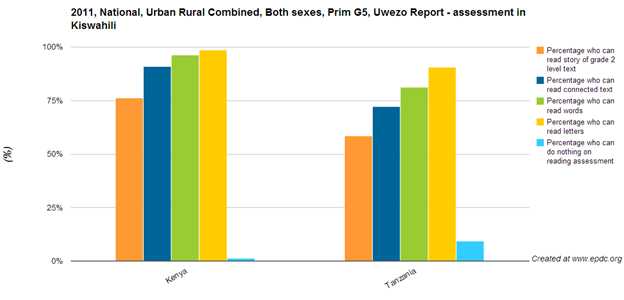You are here
UWEZO: Supporting Student Learning in East Africa
The relationship between schooling inputs and student outcomes has long been the subject of debate among education policymakers and researchers. While the bulk of research has looked at this issue in the United States and other developed countries where data are widely available, the increasing number of large-scale assessments administered in and among lower income countries provides an opportunity to investigate this relationship on a wider scale and in an increasing diversity of country and regional contexts. To what extent is learning a result of the richness (in terms of resource inputs) of the schooling environment, and how strong is the relationship?
UWEZO, a learning assessment which is conducted yearly in Tanzania, Uganda and Kenya, measures student outcomes using a simple testing instrument administered to 6-16 year olds by volunteer enumerators at the household level. It also contains a component that measures school-level characteristics. The goal with UWEZO and similar national assessments is to foster civic engagement as well as to inform policymakers about the quality of schooling. Below are presented some data on student achievement for UWEZO 2011, which are available in the EPDC database. It should be noted that UWEZO results as administered in separate countries are not designed to be cross-nationally comparable, but do provide information on the degree to which children are learning, within countries.
Figure 1 (click here to see this visualization and dataset in epdc.org website)
 Analyzing the data, classroom resources were found to be strongly associated with student learning achievement in Kenya, when controlled for student background and accounting for the unmeasured effects of their environment through a multilevel model clustered at the village and district level[1]. For example in Kenya, the odds of a pupil having the ability to read a simple short story were reduced by almost 40% if that pupil attended a school that lacked basic classroom resources, such as desks, chairs, textbooks and pencils, and basic instructional materials. Students that had to sit squeezed at their desks or sit on the floor during class were 18% less likely to pass the UWEZO basic literacy and numeracy tests than their peers in better resourced schools[2]. Similarly a one student increase in the pupil-teacher ratio was associated with a 1% reduction in odds of a student meeting the UWEZO performance benchmarks. Considering the range of pupil-teacher ratios, with the highest classrooms of 150 students per teacher across the three countries, the effect of overcrowded classrooms becomes quite visible. A strong effect of school feeding programs was found in Tanzania and Uganda (a school feeding indicator was not present in the Kenya dataset).
Analyzing the data, classroom resources were found to be strongly associated with student learning achievement in Kenya, when controlled for student background and accounting for the unmeasured effects of their environment through a multilevel model clustered at the village and district level[1]. For example in Kenya, the odds of a pupil having the ability to read a simple short story were reduced by almost 40% if that pupil attended a school that lacked basic classroom resources, such as desks, chairs, textbooks and pencils, and basic instructional materials. Students that had to sit squeezed at their desks or sit on the floor during class were 18% less likely to pass the UWEZO basic literacy and numeracy tests than their peers in better resourced schools[2]. Similarly a one student increase in the pupil-teacher ratio was associated with a 1% reduction in odds of a student meeting the UWEZO performance benchmarks. Considering the range of pupil-teacher ratios, with the highest classrooms of 150 students per teacher across the three countries, the effect of overcrowded classrooms becomes quite visible. A strong effect of school feeding programs was found in Tanzania and Uganda (a school feeding indicator was not present in the Kenya dataset).
These results indicate that students in better resourced schools are, in fact, more likely to meet the basic learning standards in primary school, holding constant their background and any socioeconomic or cultural characteristics of their neighborhoods. It is important to consider this very basic and simple fact, which nonetheless sometimes gets lost in the discussions about efficiency in the use of resources, as well as school and teacher accountability. EPDC is in the process of pulling together these findings and publishing a research paper on schooling inputs and learning outcomes in East Africa. Like us on Facebook and follow us on Twitter, and be sure to check back often to keep up to date with research and data analysis in international education.
[1] EPDC, forthcoming. A set of multilevel logit models was fit on Kenya, Tanzania, and Uganda datasets separately, with the binary outcome of “meeting UWEZO learning standards”. The dataset was restricted to children ages 9-11, attending public schools reached by the UWEZO sample.
[2] The highest level of achievement on an UWEZO test is being able to read a simple short story in English or Kiswahili AND complete simple multiplication and division problems in math. The dataset is restricted to children ages 9-11.

Add new comment